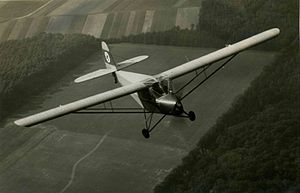Volksflugzeug
| Volksflugzeug | |
|---|---|
 |
|
| The Fieseler Fi 253 Spatz, one of the planes that were developed based on the concept of a Volksflugzeug. | |
| Issued by | Germany |
| Outcome | Program abandoned due to World War II |
The Volksflugzeug (People’s Aircraft) was a grand Third Reich scheme for the mass-production of a small and simple airplane in the 1930s. It was one of the attempts of the Nazi regime to shape progressive consumer technologies for the benefit of the community and as a powerful propaganda tool for the state. Unlike the Volkswagen car, the showpiece of the Nazi claim to work for the good of the average German, as well as the less-known Volksempfänger radio, the Volkskühlschrank refrigerator and the Volksgasmaske gas mask, the Volksflugzeug project was contemplated but never fully realized.
The Volksflugzeug grand plan surfaced at different times and in different locations in Germany during Nazi rule. However, since it lacked vehement official backing, it remained ill-defined and elusive. Finally World War II dictated priorities ended abruptly most of the projects connected with the scheme.
The idea of a ‘People's Aircraft’ predated the Nazi regime. Its main source of inspiration was Henry Ford’s Ford T. After the industrial production of a cheap car that the ordinary citizen could afford was made possible, there was only one step in the minds of some towards building an aircraft on the same pattern. The idea of a ‘People's Plane’ was put forward to Henry Ford by William Bushnell Stout and Ford immediately became enthusiastic about it. The Ford Flivver was the resulting plane, a project that ended up not becoming as successful as expected.
In Germany itself, some projects in the second half of the 1920 decade were intended as early Volksflugzeug planes. Already in 1928 the Raab-Katzenstein RK-9 Grasmücke (Warbler) was a 2-seat biplane trainer fitted with a 3-cylinder Anzani motor that was planned as a 'Volksflugzeug'. The Etrich Sport-Taube, built in 1929 by the Etrich company, was also intended as a Volksflugzeug, but it soon faced difficulties regarding production in series and the project was given up. Other early People’s Aircraft projects were the Deicke ADM 11 Volksflugzeug built in 1933, the Gerner G.I and G.II biplanes, and the Messerschmitt M 17.
...
Wikipedia
